Passive And Active Voice
Verbs and Voice
- Voice is the form a verb takes to indicate whether the subject of the verb performs or receives the action.
- There are two types of voice: active voice and passive voice.
Active Voice
- Active Voice – indicates that the subject of the verb is acting
- Because the subject does or "acts upon" the verb in such sentences, the sentences are said to be in the active voice .
- These examples show that the subject is doing the verb's action.
- The dog jumped onto the boy.
The dog ( subject ) is doing the jumping ( verb ).
- Sam will give a book report to the class.
Sam ( subject ) is doing the giving ( verb ).
- The computer ate my paper.
The computer ( subject ) is doing the eating ( verb ).
Passive Voice
- In a passive voice sentence , the subject and object flip-flop. The subject becomes the passive recipient of the action.
- Because the subject is being "acted upon" (or is passive ), such sentences are said to be in the passive voice .
- These examples show the subject being acted upon by the verb.
- The boy was jumped on by the dog.
- Boy ( subject ) was being jumped on ( verb )
- A book report will be given by Sam to the class.
- Report ( subject ) will be given ( verb ).
- My paper was eaten by the computer.
- Paper ( subject ) was being eaten ( verb ).
Reasons to Use the Active Voice
- Most writers prefer to use active voice because it is more direct.
- Active : The waiter dropped the tray of food.
- Passive : The tray of food was dropped by the waiter.
- The active voice is less awkward and clearly states relationship between subject and action.
- Passive : Your request for funding has been denied by the review committee.
- Active : The review committee denied your request for funding.
- The active voice sentence pattern propels the reader forward through your writing thus avoiding weak prose.
When to Use Passive Voice
- In general, the passive voice is less direct, less forceful, and less concise than the active voice.
- Use the passive voice in the following situations:
- Use passive voice when you do not know or do not want to reveal the performer of an action.
- Use passive voice when you want to emphasize the receiver of an action.
- Awkward Passive : My bicycle was repainted by John.
- Deliberate Passive : My bicycle was repainted. ( The performer is not mentioned and the emphasis is on the bicycle. )
Form of Passive Voice Verbs
- The passive voice requires a "double verb" and will always consist of a form of the verb " to be " and the past participle (usually the " en/ed/t " form) of another verb.
Active: John baked the bread.
Passive: The bread was baked by John. ( Was is a form of the verb “be”.)
- Writers should be familiar with the forms of "to be" , often called linking verbs, so that they can easily identify the passive voice in their work.
- Review the forms of " to be ":
- am, is, are, was, were, be, being, been
- Note the forms of "to be" in the examples of the verb "to kick" in various forms of the passive voice:
is kicked--------------had been kicked� was kicked----------is going to be kicked� is being kicked---------will be kicked� has been kicked-------can be kicked� was being kicked------should be kicked
- Often passive voice sentences will contain a " by " phrase indicating who or what performed the action.
- Passive sentences can be easily transformed into active sentences when the object of the preposition " by " is moved to the subject position in the sentence.
- Passive : The cookies were eaten by the children.
- Active : The children ate the cookies.
- Passive: The tunnels are dug by the gophers.
- Active: The gophers dug the tunnels.
Let’s Practice
- Directions : Change the sentences below to the active voice .
- The statue is being visited by hundreds of tourists every year.
- My books were stolen by someone yesterday.
- These books had been left in the classroom by a careless student.
- Coffee is raised in many parts of Hawaii by plantation workers.
- The house had been broken into by someone while the owners were on vacation.
- Directions : Change the sentences below to the passive voice .
- Children cannot open these bottles easily.
- The government built a road right outside her front door.
- Mr. Ross broke the antique vase as he walked through the store.
- When she arrived, the changes amazed her.
- The construction workers are making street repairs all month long.

BusyTeacher.org
Passive voice: powerpoint presentation and practice.

- Passive Voice Presentation
- Present and Past Passive Voice
- Passive Voice Usage
16,156 English ESL powerpoints
Teach Starter, part of Tes Teach Starter, part of Tes
Search everything in all resources
Active Voice and Passive Voice PowerPoint
Updated: 20 Apr 2020
A 13 slide editable PowerPoint template to use when teaching your students about active voice and passive voice.
Editable: PowerPoint
Non-Editable: PDF
Pages: 13 Pages
Years: 5 - 6
- Adobe Reader (pdf) Sign up to Plus
- Microsoft PowerPoint (potx) Sign up to Plus
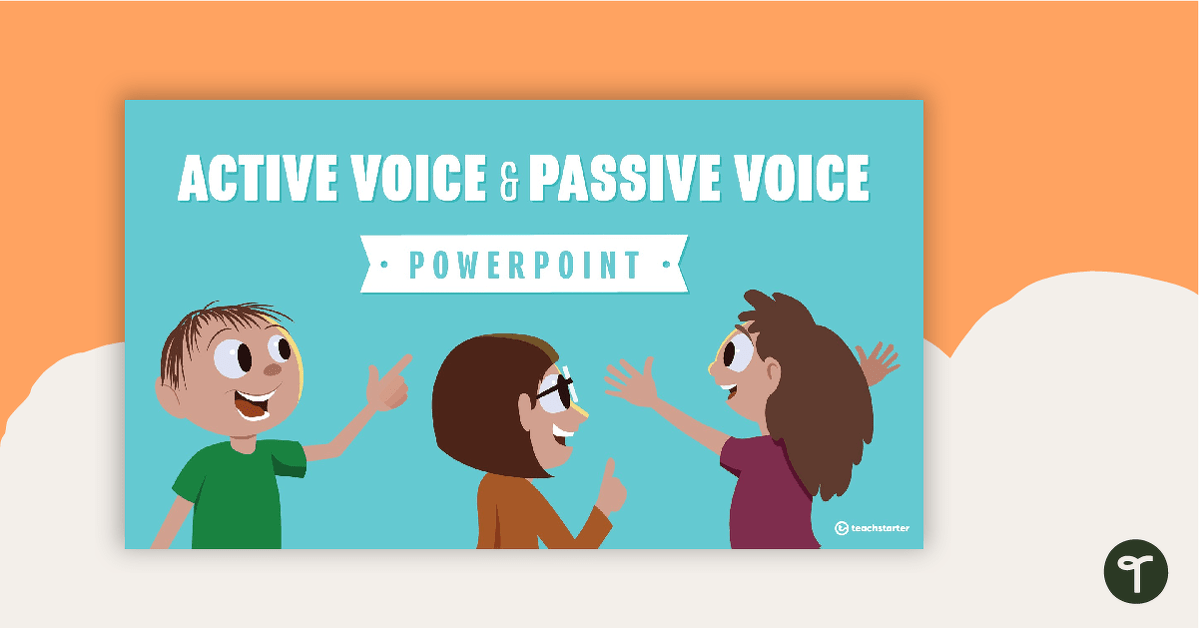
Use this teaching resource when explaining the concept of active voice and passive voice to your students.
This PowerPoint presentation includes:
- informative slides
- whole class activities
- an independent task.
Teach Starter Publishing
We create premium quality, downloadable teaching resources for primary/elementary school teachers that make classrooms buzz!
Write a review to help other teachers and parents like yourself. If you'd like to request a change to this resource, or report an error, select the corresponding tab above.
Suggest a Change
Would you like something changed or customised on this resource? While our team makes every effort to complete change suggestions, we can't guarantee that every change will be completed.
Report an Error
Did you spot an error on this resource? Please let us know and we will fix it shortly.
Are you having trouble downloading or viewing this resource? Please try the following steps:
- Check that you are logged in to your account
- For premium resources, check that you have a paid subscription
- Check that you have installed Adobe Reader ( download here )
If you are still having difficulty, please visit the Teach Starter Help Desk or contact us .
You may also like
- Sentence Structure →
- Teaching Presentations →
- PowerPoint →

Adjective Grammar Card Game – Flip It!
A fun game for students to play in small groups to consolidate their understanding of adjectives.
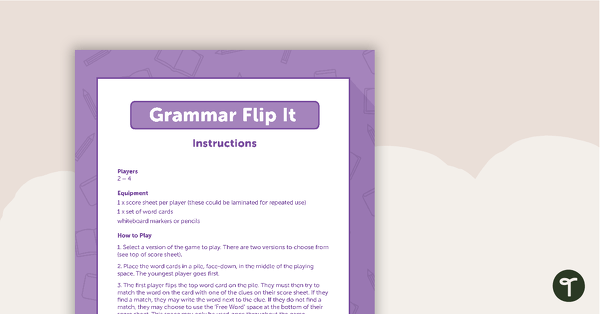
Adverb Grammar Card Game – Flip It!
A fun game for students to play in small groups to consolidate their understanding of adverbs.

Queensland Cursive Entries and Exits Spaceship - Blue
A set of 12 Queensland Cursive entry and exit shuttles to join together to make a handwriting spaceship.
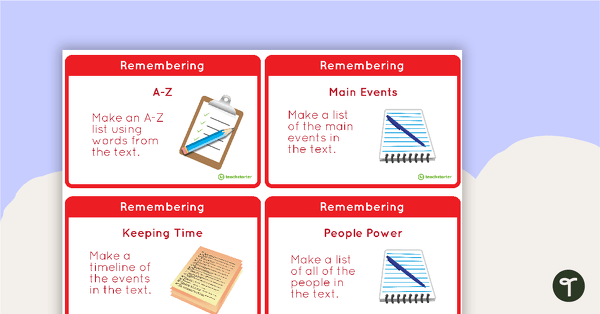
Bloom's Taxonomy Fast Finisher Task Cards - Upper Years
44 Bloom's Taxonomy fast finisher activity cards.
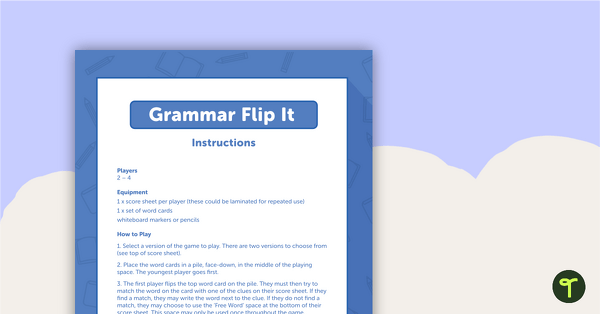

Verb Grammar Card Game – Flip It!
A fun game for students to play in small groups to consolidate their understanding of verbs.

Queensland Cursive Entries and Exits Spaceship - Purple

Queensland Cursive Entries and Exits Spaceship - Red
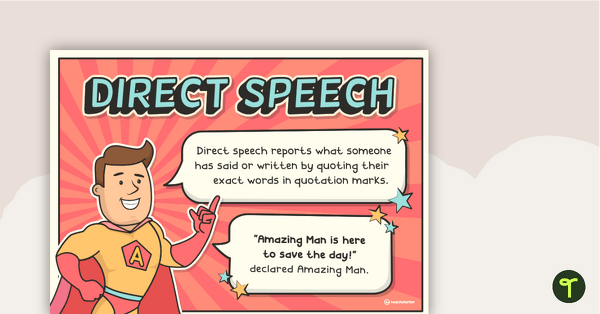
Direct and Indirect Speech Posters
Amazing Man helps students to learn what both direct and indirect speech entails as well as providing examples on how they can use it themselves.
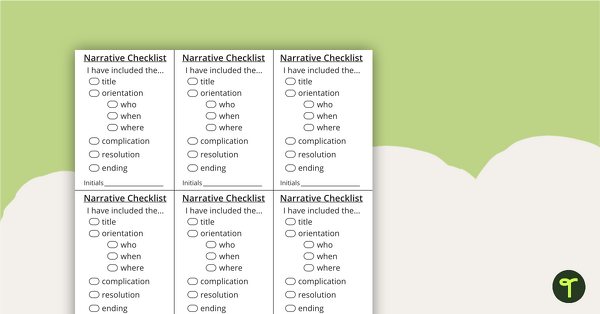
Writing Checklists - Various Genres
Use these Writing Checklists to ensure that your students have everything they need in their pieces of writing.

Desk Plate Alphabet and Number Line - Butterflies and Lady Bugs
Lower Grade Desk Plates with the alphabet, number line and student's name on them.
- Preferences

The Passive Voice - PowerPoint PPT Presentation

The Passive Voice
Use of the passive the passive voice is used when the focus is on the action. it is not important or not known, however, who or what is performing the action. – powerpoint ppt presentation.
- Example My bike was stolen.
- In the example above, the focus is on the fact that my bike was stolen. I do not know, however, who did it.
- 2. Sometimes a statement in passive is more polite than in active voice, as the following example shows
- Example A mistake was made.
- In this case, I focus on the fact that a mistake was made, but I do not blame anyone (e.g. You have made a mistake!!)
- Murderes are usually sentenced to life imprisonment.
- The trial is being held at the moment.
- My car has been stolen.
- Jim was arrested last year.
- The cinema was being rebuilt when it was set on fire.
- We saw that one of the windows had been broken.
- The prisoner will be released next month.
- The verdict is going to be given tomorrow.
- People used to be imprisoned for stealing bread.
- You can be fined for parking on a yellow line.
- He paid a fine to avoid being sent to jail.
- We do not use the Present Perfect Continuous and Past Perfect Continuous in the passive
- He has/had been being arrested (WRONG!!!)
- After certain verbs (e.g. enjoy) we use being past participle
- Everyone enjoys being told they are good at what they do
- After certain verbs (e.g want) we use to be past participle
- Most of us want to be rewarded in some way.
- After prepositions we use beingpast participle
- Every actor dreams of being nominated for an Oscar.
- After the first/second/last (noun) we use to bepast participle
- The first Academy Awards ceremony to be televised was in 1953.
- After have to and used to we use bepast participle
- The ceremony had to be postponed in 1993 because of a
- Newspapers used to be given the winnersnames in
- After modal verbs we use bepast participle
- The names wouldnt be published until afterwards.
- Note We can use all modal verbs (can, must, will, could,
- might, etc)in passive verb forms.
- He cant be trusted. All bags must be checked in at
- This formal structure is used in news reports and on tv with the verbs KNOW, TELL, UNDERSTAND, REPORT, EXPECT SAY and THINK.
- It makes the information sound MORE IMPERSONAL!
- It is said that the company may close.
- It is thought that prices will go up.
- The man is said to be in his 40s.
- He is believed to have left the country.
- 1. We should clean these windows before tomorrow.
- 2. The workers gave the boss some flowers.
- 3. The police followed the thieves into a building.
- 4. The mechanic cant fix my car.
- 5. The neighbour has told us the news.
- 6. The students painted the walls last year.
- 7. The old woman feeds the pigeons every day.
- 8. They will pick up John at this office.
- 9. She showed the visitors the new house.
- 10. You shouldnt throw litter on the ground.
- 11. The teacher asked the students a very difficult question at the oral exam.
- 12. First, we have to read the text and then, we have to do the
- 13. His parents promised Tom a hundred Euros if he passed the test
- 14. Did they repair all the windows?
- 15. The news surprised us all.
PowerShow.com is a leading presentation sharing website. It has millions of presentations already uploaded and available with 1,000s more being uploaded by its users every day. Whatever your area of interest, here you’ll be able to find and view presentations you’ll love and possibly download. And, best of all, it is completely free and easy to use.
You might even have a presentation you’d like to share with others. If so, just upload it to PowerShow.com. We’ll convert it to an HTML5 slideshow that includes all the media types you’ve already added: audio, video, music, pictures, animations and transition effects. Then you can share it with your target audience as well as PowerShow.com’s millions of monthly visitors. And, again, it’s all free.
About the Developers
PowerShow.com is brought to you by CrystalGraphics , the award-winning developer and market-leading publisher of rich-media enhancement products for presentations. Our product offerings include millions of PowerPoint templates, diagrams, animated 3D characters and more.

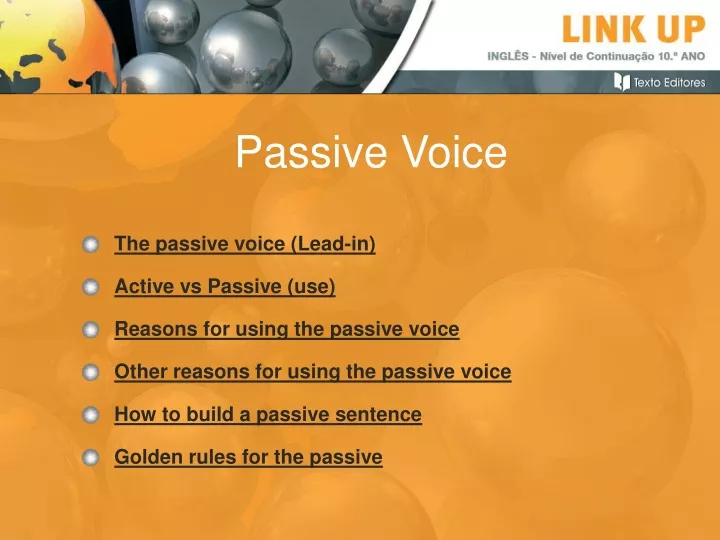
Passive Voice
Jan 02, 2020
410 likes | 984 Views
Passive Voice. The passive voice (Lead-in). Active vs Passive (use). Reasons for using the passive voice. Other reasons for using the passive voice. How to build a passive sentence. Golden rules for the passive. The Passive Voice (Lead-in). Read the following sentences:.
Share Presentation
- passive voice
- passive sentences
- passive sentence
- main verb appears

Presentation Transcript
Passive Voice The passive voice (Lead-in) Active vs Passive (use) Reasons for using the passive voice Other reasons for using the passive voice How to build a passive sentence Golden rules for the passive
The Passive Voice (Lead-in) Read the following sentences: • ICYE offers volunteers a wide choice of placements. • Volunteers are encouraged by ICYE to get involved in the host community. Answer these questions. In which sentence… • is ICYE the main issue? • are the volunteers the main issue? • is the subject the doer of the action? • is the subject the receiver of the action? • does the subject feel the effects of the action?
Active vs Passive (use) • When the focus is on who does the action (the agent), the sentence is ACTIVE. • When the focus is on what is done (the action), the sentence is PASSIVE.
Reasons for using the passive The poor Indian communities will be provided with help by ICYE. • We choose between active and passive structures because of the topic we are talking about and the emphasis we want to put on it, especially when reporting information. Look at the following example: If ICYE issues a newsletter to report on a new voluntary project in India, assuming its readers are interested in joining it, that would make it the topic and it would most likely be reported like this: ICYE will provide help to the poor Indian communities. ACTIVE On the other hand, a local Indian newspaper would be more interested in what is happening in its own country, and would make that the main topic, most likely reporting the information like this: PASSIVE
Other reasons for using the passive • The agent is unknown or obvious: • “Volunteers are encouraged to live and participate in the community.” • (The agent is obviously ICYE.) • The agent is ‘people or things in general’: • “An application form can be filled in online.”(The agent is people in general) • Avoiding references to ourselves and making a statement impersonal: • “A foreign language can’t possibly be learnt overnight.” • Avoiding ‘you’ in orders and rules: • “Application forms must be given in before the end of the week.” • In factual writing when the focus is usually on events, achievements, etc., rather than agents: • “Volunteering is becoming a well-known activity all over the world.”
NOTE In most passive sentences we have no interest in who or what performs the action. We are interested in the action itself, who or what is affected by the action or in its result .
How to build a passive sentence support volunteers ICYE Active Structure S V O supported Volunteers are by ICYE Passive Structure Agent S Aux. V Main V
GOLDEN RULES FOR THE PASSIVE
The object of the active structure becomes the subject of the passive structure. support volunteers ICYE Active Structure (S) (V) (O) Passive Structure Volunteers (S)
The subject of the active structure becomes the agent of the passive structure after by(ONLY IF IT ADDS IMPORTANT INFORMATION). support volunteers ICYE Active Structure (S) (V) (O) Volunteers by ICYE Passive Structure (S) (Agent)
The auxiliary verb (to be) is used in the passive structure and always comes in the same verb form in which the main verb appears in the active structure. support volunteers ICYE Active Structure (S) (V) (O) Volunteers are by ICYE Passive Structure (S) (Aux. V.) (Agent)
The main verb of the active structure always comes in the Past Participle in the passive structure. support volunteers ICYE Active Structure (V) Volunteers are by ICYE supported Passive Structure Main v.
- More by User

Passive voice
Passive voice. The reward of a thing well done is to have done it . Ralph Waldo Emerson. Se forma con el verbo “to be” + Past Participle. Usos:. Cuando el que realiza la acción ( AGENTE) es desconocido, o poco importante. My house was painted
748 views • 47 slides

546 views • 13 slides
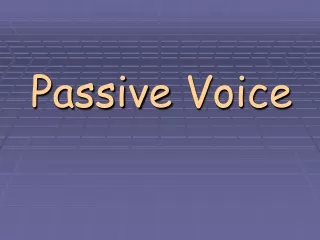
Passive Voice. actor. non-actor. action. made. these chairs. My uncle. my uncle. were made. by. These chairs. non-actor. action. actor. Main forms of the passive verb phrase. (singular). 1- Present Simple. The room is cleaned by Masa. Masa cleans the room. Masa cleans the rooms.
1.41k views • 10 slides

IMAGES
COMMENTS
PASSIVE VOICE PPT. This is a power poin. 20559 uses. latsa67. Passive Voice. A comprehensive pres. 19904 uses. loveteaching. SPIN THE WHEEL - gra. This PPT was designe. 16968 uses. Djasolina. passive voice lesson. lesson about passive. 11954 uses. monicareig. Passive voice Exerci. Here you've got a po. 11584 uses. knds.
The passive voice requires a "double verb" and will always consist of a form of the verb "to be" and the past participle (usually the "en/ed/t" form) of another verb. Example: Active: John baked the bread. Passive: The bread was baked by John. (Was is a form of the verb "be".) Form of Passive Voice Verbs.
Passive Voice. VOICE. Active voice: "Voice" refers to the relationship between the subject and the verb in a sentence. A sentence is said to be in an ACTIVE VOICE if the subject performs the action of the verb. The dog bit the child. Mary will introduce her husband tomorrow. Researchers have analised deeply the results.
This PowerPoint presentation has a quick overview of the whole Passive Voice form. It also has exercises and practice for the students. Students get to practice common passive structures (Present Simple, Past Simple, Present Continuous, etc.). There are also a few stories that I pulled off of news sites that your students can make better by ...
Most writers prefer to use active voice because it is more direct. Compare: Active : The waiter dropped the tray of food. Passive : The tray of food was dropped by the waiter. . Reasons to Use the Active Voice. The active voice is less awkward and clearly states relationship between subject and action. Compare.
This PowerPoint presentation has a quick overview of the whole Passive Voice form. It also has exercises and practice for the students. Students get to practice common passive structures (Present Simple, Past Simple, Present Continuous, etc.). There are also a few stories that I pulled off of news sites that your students can make better by ...
Passive voice. A simple explanation of passive voice with fun practice activity for students of intermediate level. This powerpoint file can be used for introducing the new gramma... 3952 uses. laprof55.
The Passive Voice. The Passive Voice. The Passive Voice. If a sentence is in the active voice, usually the subject is the topic and the verb flows left to right, exerting the influence of the subject on the object. Ex. Ich kaufe einen Kuli. "I" being the subject, "to buy" is the verb and "a pen" is the object. 397 views • 19 slides
zip, 309.07 MB. This is an interactive PowerPoint lesson for B1 level students of English focusing on the grammatical structure of using the passive voice. This lesson contains 37 beautifully animated slides and also includes one handout that is incorporated into the lesson. The handout can be completed in person, digitally, or as homework ...
This PowerPoint Presentation is perfect for teaching Grammar - Active and Passive Voice. These no prep activities would be great for ELA lessons or ELA centers. Your students will love these exercises that are carefully planned for student engagement. After attempting these New Bloom's Taxonomy-based activities students will be able to:
introduction to the presentation The aim of this presentation is to explain the concept of passive voice practically. The slides include, in order, the following: • Definitions of both active and passive voices • Simple examples of both • How to form a passive voice sentence from an active sentence. • Passive voice flash cards ...
A comprehensive Passive Voice PowerPoint Presentation that has animation and a lot of various exercises on different tenses and forms. Tenses covered are the simple present, the present perfect, the present progressive, the present perfect progressive and more.
A 13 slide editable PowerPoint template to use when teaching your students about active voice and passive voice. Use this teaching resource when explaining the concept of active voice and passive voice to your students. This PowerPoint presentation includes: informative slides. whole class activities. an independent task.
The Passive Voice. The Passive Voice. The Passive Voice. If a sentence is in the active voice, usually the subject is the topic and the verb flows left to right, exerting the influence of the subject on the object. Ex. Ich kaufe einen Kuli. "I" being the subject, "to buy" is the verb and "a pen" is the object. 398 views • 19 slides
The Passive Voice. Description: Use of the Passive The Passive voice is used when the focus is on the action. It is not important or not known, however, who or what is performing the action. - PowerPoint PPT presentation. Number of Views: 1040. Avg rating:3.0/5.0. Slides: 24. Provided by: Isabel114.
Presentation Transcript. Passive Voice The passive voice (Lead-in) Active vs Passive (use) Reasons for using the passive voice Other reasons for using the passive voice How to build a passive sentence Golden rules for the passive. The Passive Voice (Lead-in) Read the following sentences: • ICYE offers volunteers a wide choice of placements.
Age range: 11-14. Resource type: Other. File previews. ppt, 214 KB. Active and passive voice. A resource with a Powerpoint lesson (for Year 7) presentation explaining the difference in these grammatical structures. Creative Commons "Sharealike". great resource. it unfolds nicely. excellent simple explanation.
Just point, click, teach! This huge PPT (19 slides) is designed for ESL teachers to help explain not only how to form and use Passive Voice but how to turn sentences from active voice into the passive. The exercises are graded from very easy tasks (to fill in only the verb) up to the difficult ones (to turn whole sentences into the Passive).